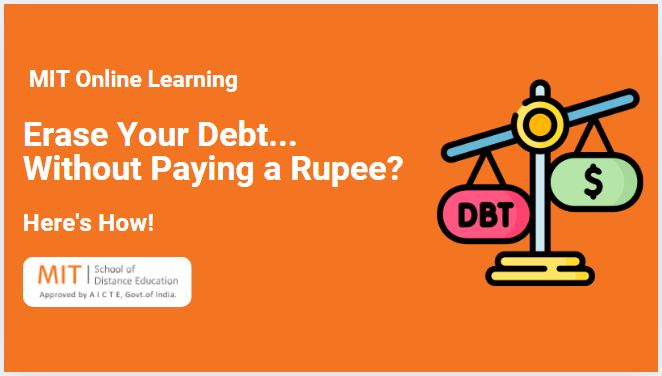
Managing finances is a must-have skill for any adult, as money plays a crucial role in every aspect of life. To fulfill dreams and aspirations, it often becomes necessary to take on loans and debt based on individual needs.
What Is Debt?
Debt is essentially an obligation to repay a sum of money, goods, or services borrowed from another party. It’s a financial arrangement in which one person or entity (the debtor) owes money to another (the creditor) and agrees to repay it over a set period—often with interest.
Debt can be a useful tool when used responsibly, but it must be managed carefully. It’s important to understand the potential consequences of accumulating debt.
Some types of debt can help generate wealth—such as a mortgage for buying a home—or increase future income, such as student loans for higher education. However, consumer debt like credit cards, auto loans, or personal loans does not increase your net worth or future income. These items often depreciate over time.
That’s why it’s essential to learn practical strategies that can help you get out of debt without incurring extra expenses.

Step 1: Stop Incurring Debt
- Budgeting – Maintaining a budget is essential for managing both debts and expenses. When you take on debt, you divert cash flow toward interest payments instead of using it for other financial goals. Set clear financial goals and stick to a realistic budget.
- Emergency Fund – An emergency fund is a financial cushion set aside specifically for unplanned expenses. A good rule of thumb is to save enough to cover 3–6 months of expenses, depending on your situation.
- Insurance – Just like an emergency fund, insurance helps prevent unexpected financial shocks. Ensure you have adequate health, home, business, and auto insurance to avoid falling into debt during emergencies.
Step 2: Pay Off Debt
- Snowball Method – This method helps individuals gain momentum by paying off smaller debts first:
- List your debts from smallest to largest.
- Make minimum payments on all debts except the smallest.
- Use extra money to pay off the smallest debt.
- Repeat the process.
- List your debts from smallest to largest.
- Avalanche Method – This approach is more interest-efficient:
- List debts by interest rate, from highest to lowest.
- Focus all extra payments on the highest-interest debt.
- Continue down the list as each is paid off.
- List debts by interest rate, from highest to lowest.
- Negotiate with Creditors – Contact lenders to negotiate new terms. Speak with authorized managers and always get agreements in writing.
Step 3: Use Caution
- Debt Consolidation – Combine multiple loans into one with a lower interest rate. This reduces complexity and can lower monthly payments—but only if you secure a better rate.
- Debt Settlement – Involves hiring a third party to negotiate lump-sum payments with creditors. Be aware that companies often charge 15–20% of the total debt as fees.
Debt Collection – If contacted by a debt collector, verify the debt before making payments. Dispute inaccuracies. In some regions, like California, you have specific consumer rights.

Want to Go Beyond Life Hacks? Upskill with MITSDE
While these financial strategies can help you personally, professional growth requires structured education. MITSDE offers industry-relevant, AICTE-approved finance courses to boost your career.
PGDM in Finance Management
A PGDM in Finance Management prepares you to manage cash flows and working capital effectively. The growing demand in banking, insurance, and venture capital has expanded job opportunities in the finance sector.
This finance management course is designed to meet industry demands. It covers essential financial functions such as bookkeeping, budgeting, accounting, and reporting. The curriculum is created by experienced finance professionals and updated to reflect industry trends.
👉 Explore PGDM in Finance Management
PGDM Executive in Finance Management
This 15-month program is ideal for professionals aiming to move into leadership roles in corporate finance, banking, or consulting. It blends core business modules with specialized subjects like International Finance, Portfolio Management, and Mergers & Acquisitions.
Case studies, real-world assignments, and tools like Business Analytics enhance learning. Delivered online, this finance training lets you upskill without pausing your career.
👉 Explore PGDM Executive in Finance Management
Professional Certification in Finance Management
This short-term finance certification course is perfect for professionals and business owners. Learn budgeting, financial forecasting, risk management, and profitability strategies.
👉 Explore Certification in Finance Management
PGDM in Banking & Financial Services
This finance course dives deep into the evolving digital financial landscape. Covering personal, corporate, and consumer finance, the curriculum includes emerging trends in insurance, mutual funds, and digital banking.
👉 Explore PGDM in Banking & Financial Services
PGDM Executive in Banking & Financial Services
Designed for professionals, this executive program focuses on analyzing market shifts, investment patterns, and digital trends in banking. You’ll learn to manage portfolios and optimize financial strategies for growth.
👉 Explore PGDM Executive in Banking & Financial Services
Final Thoughts
Managing finances is a critical yet often challenging task. Equip yourself with life hacks to handle your personal finances—and consider leveraging the power of education through MITSDE’s top-tier programs. It’s a smart way to upskill professionally while mastering the essentials of financial service management.



